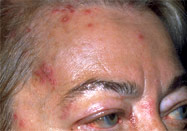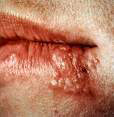



Herpes simplex is a viral disease caused by both herpes simplex virus types 1 (HSV-1) and type 2 (HSV-2). Infection with the herpes virus is categorized into one of several distinct disorders based on the site of infection.
Oral herpes, the visible symptoms of which are colloquially called cold sores or fever blisters, infects the face and mouth. Oral herpes is the most common form of infection.
Genital herpes, known simply as herpes, is the second most common form of herpes. Herpetic whitlow, herpes gladiatorum, ocular herpes (keratitis), cerebral herpes infection encephalitis, Mollaret's meningitis, neonatal herpes, and possibly Bell's palsy can all be caused by herpes simplex viruses.
Herpes viruses cycle between periods of active disease—presenting as blisters containing infectious virus particles—that last 2–21 days, followed by a remission period, during which the sores disappear. Genital herpes, however, is often asymptomatic, though viral shedding may still occur. After initial infection, the viruses move to sensory nerves, where they become latent and reside life-long. Causes of recurrence are uncertain, though some potential triggers have been identified. Over time, episodes of active disease reduce in frequency and severity.
Herpes simplex is most easily transmitted by direct contact with a lesion or the body fluid of an infected individual. Transmission may also occur through skin-to-skin contact during periods of asymptomatic shedding. Barrier protection methods are the most reliable method of preventing transmission of herpes, but they merely reduce rather than eliminate risk. Oral herpes is easily diagnosed if the patient presents with visible sores or ulcers. Early stages of orofacial herpes and genital herpes are harder to diagnose; laboratory testing is usually required.
Once infected, the virus remains in the body for life. However, after several years, some people will become perpetually asymptomatic and will no longer experience outbreaks, though they may still be contagious to others.
Herpes simplex type 1 causes cold sores and fever blisters in the mouth and the surrounding area.
Herpes simplex type 2, also known as human herpes virus 1 (HHV-1), causes genital herpes, a sexually transmitted disease (STD). A viral infection transmitted through intimate contact with the moist mucous linings of the genitals. This contact can involve the mouth, the vagina or the genital skin. The herpes simplex type 2 (HSV-2) enters the mucous membranes through microscopic tears. Once inside the body, HSV-2 travels to nerve roots near the spinal cord and settles there permanently. When an infected person has a herpes outbreak, the virus travels down the nerve fibers to the site of the original infection and when it reaches the skin, the classic redness and blisters occur. Sores in the genital area characterize genital herpes. Both genital and oral herpes simplex types 1 and 2 are capable of causing systemic disease including encephalitis (infection of the brain) in someone who is immunodeficient.
Many people acquire the virus and have no symptoms. For others, painful blisters appear near the area where the virus entered the body. Typically, the blisters heal completely but reappear at some point in the future when least expected (or desired). In between attacks, the virus resides deep in the roots of the nerves that supply the involved area. When herpes simplex lesions appear in their most common location, around the mouth and lips, people often refer to them as "cold sores" and "fever blisters.
Herpes simplex is divided into two types:
HSV type 1: HSV1 primarily effects mouth, throat, face, eye, and central nervous system infections thus also called as oral herpes HSV2 primarily causes anogenital infections. Thus known as genital herpes. However, each (HSV1 and HSV2) may cause infections in all areas. On the site of infection
Oral herpes: It is one of the most common forms of herpes
- Oral sores: The most intense pain caused by these sores occurs at the onset and may make eating and drinking difficult. Which might lead to dehydration
- The sores may occur on the lips, gums, throat, the front of the tongue, the inside of the cheeks, and the roof of the mouth.
- They may also extend down the chin and neck.
- The gums may become mildly swollen, red-colored, and may bleed.
- Neck lymph nodes often swell and become painful.
- People in their teens and 20s may develop a painful throat with shallow ulcers and a grayish coating on the tonsils. They may also extend down the chin and neck.
- The gums may become mildly swollen, red-colored, and may bleed.
- Neck lymph nodes often swell and become painful
- People in their teens and 20s may develop a painful throat with shallow ulcers and a grayish coating on the tonsils.
The sores heal completely in two to six weeks, usually without scarring. Virus can be recovered from the saliva for days after the lesions heal. Primary herpes refers to the first episode of symptoms after infection, often presenting with painful sores on the lips, gums, and mouth. Primary herpes is usually contracted during childhood.
Genital Herpes: It is the second most common type of herpes
Signs of genital herpes tend to develop within three to seven days of skin-to-skin contact with an infected person. Genital herpes infections look like small blisters or ulcers (round areas of broken skin) on the genitals. Each blister or ulcer is typically only 1 to 3 millimeters (1/32 inch to 1/8th inch) in size, and the blisters or ulcers tend to be grouped into "crops." Usually the blisters form first, then soon open to form ulcers. Herpes infections may be painless or slightly tender. In some people, however, the blisters or ulcers can be very tender and painful.
Location of genital herpes
- In men, genital herpes sores (lesions) usually appear on or around the penis.
- In women, the lesions may be visible outside the vagina, but they commonly occur inside the vagina where they can cause discomfort or vaginal discharge but cannot be seen except during a doctor's examination.
- The ulcers or blisters may also be found anywhere around the genitals (the perineum) and in and around the anus.
The first genital herpes outbreak is usually the most painful, and the initial episode may last longer than later outbreaks. Symptoms may last for two to four weeks. Some people develop other signs of genital herpes infection, particularly with the first episode including:
- Flu-like symptoms such as swollen glands, fever, headache and tiredness
- Stinging and/or itching in the genital area
- Painful red blisters around the external genital area, rectum, buttocks and thighs, which burst and leave sores
- Pain when urine comes into contact with sores
- Muscle aches,
- Headaches (may be severe),
- Vaginal discharge Swollen and tender lymph nodes in the groin (these swell as the body tries to fight the infection). Later outbreaks of genital herpes
- If the disease returns, later outbreaks generally have much less severe symptoms. Many people with recurrent disease develop pain or a tingling sensation in the area of the infection even before any blisters or ulcers can be seen. This is due to irritation and inflammation of the nerves leading to the infected area of skin. These are signs that an outbreak is about to begin. The condition is particularly contagious during this period, even though the skin still appears normal.
 Autoinoculation: Herpes can be spread from one area to another on the same person, which is called "autoinoculation." For example, touching a cold sore on the lip can cause herpes of the finger (herpetic whitlow). Autoinoculation occurs most commonly at the time of primary infection, when viral shedding is high and the immune system is still gearing up to contain it.
Autoinoculation: Herpes can be spread from one area to another on the same person, which is called "autoinoculation." For example, touching a cold sore on the lip can cause herpes of the finger (herpetic whitlow). Autoinoculation occurs most commonly at the time of primary infection, when viral shedding is high and the immune system is still gearing up to contain it.Recurrent Infection: By far the most common manifestation of herpes infections is a recurrence of the virus when it is reactivated from its latent state in the nerves below the skin. The frequency and severity of recurrent outbreaks vary greatly between patients. Some individuals' outbreaks can be quite debilitating with large, painful lesions persisting for several weeks, while others will experience only minor itching or burning for a few days
Ocular herpes: lesions and severe pain around the eye characterize it. Ocular herpes is also caused by autoinoculation. If not treated, ocular herpes can lead to serious damage or even blindness.
Encephalitis: Rarely, herpes simplex may infect the brain Erythema nodosum: It is a nonspecific skin reaction characterized by red and painful skin lumps that usually appear on the front side of the legs.
- A sample (tissue or fluid) from the sores to identify the virus as HSV
- A viral culture analysis
- A staining test called the Tzanck smear
- Antigen and antibody studies
A broad criterion of how the homoeopathic medicines act in cases of herpes is mentioned below. The response to treatment can differ from one individual to another patients are advised to consult so that the mode of treatment can be discussed pertaining to their particular case
Relieves Symptoms like:
- Itching
- Skin lesions
- Dryness of skin
- Tenderness
- Flu-like symptoms such as swollen glands, fever, headache and tiredness
- Stinging and/or itching in the genital area
- Painful red blisters around the external genital area, rectum, buttocks and thighs, which burst and leave sores
- Pain when urine comes into contact with sores
- Muscle aches,
- Headaches,
- Vaginal discharge
- Removes scars and marks
Our deep acting constitutional medicines work at the root level. Homoeopathy with its natural medicinal substances used in small quantities cures herpes inside out. We at DRSS provide our patients with diet charts, exercise schedules and guide them how to modify their lifestyle so that better results can be achieved. Homoeopathic medicines if taken under proper guidance from a well-qualified professional are extremely safe and have no side effects.





